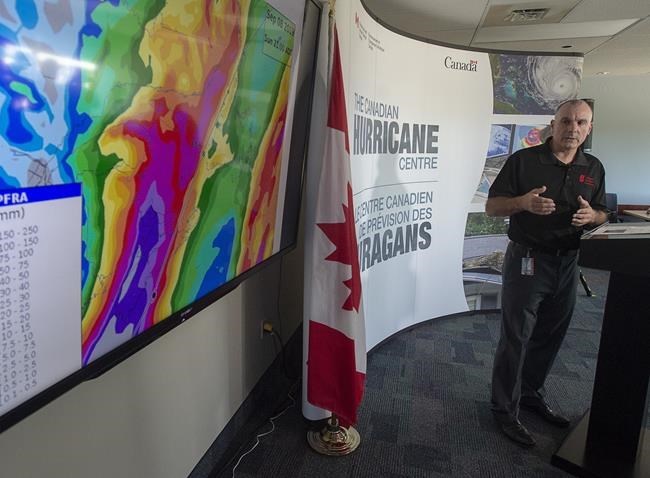HALIFAX — The Canadian Hurricane Centre is predicting another active hurricane season this year, citing the persistence of warmer-than-average ocean temperatures.
"Everything is pointing in that direction," meteorologist Bob Robichaud told the annual pre-season briefing Friday. "We're pretty confident to say it won't be as active as 2020, but it will be more active than the 30-year average."
A total of 30 named storms were recorded in 2020 — the highest number on record.
Robichaud said a storm brewing in the middle of the Atlantic has a 90 per cent chance of becoming the first named storm of the season within the next five days — even though the season doesn't start until June 1.
By early Thursday, the storm was about 1,100 kilometres east of Bermuda. If the low-pressure system transforms into tropical storm Ana, its formation would mark the seventh consecutive year a named storm has developed ahead of the official start of the Atlantic hurricane season.
An average of four named storms enter the Canadian Hurricane Centre's response zone every year. "But it takes only one storm to make it a bad year," Robichaud said.
Meanwhile, the U.S.-based National Oceanic and Atmospheric Administration also called for a busy season Thursday, saying there could be between 13 and 20 named storms this year, which could include between six and ten hurricanes.
An average season produces about 14 tropical storms and seven hurricanes. A Category 1 hurricane produces sustained winds in excess of 119 kilometres per hour.
"Hurricanes take heat that is stored in the ocean and they pump it into the atmosphere to balance the ocean temperatures," Robichaud said. "When you see warmer than average temperatures in the Atlantic ... that's one of the drivers."
As well, the atmospheric phenomenon known as El Niña could also play a role, he said.
With an El Niña period just coming to an end, sea surface temperatures across the eastern part of the central Pacific Ocean have been cooled, which can contribute to the creation of more tropical storms over the Atlantic.
American meteorologists are expecting between three and five major hurricanes to appear. The annual average is three. A major hurricane generates sustained winds at 177 km/h.
On another front, Robichaud said the process for naming storms has changed for 2021, mainly because there was confusion last year when the alphabetical list was exhausted and the Greek alphabet was used.
Some of the similar-sounding Greek names — like Zeta and Eta — made it difficult for people to distinguish between storms. As a result, the World Meteorological Organization drafted a permanent list of 21 supplemental names. The new list is similar to the annual list in that it uses a mix of male and female names drawn from English, French and Spanish origins.
Last year, eight named storms entered the Canadian zone, but only four of them warranted bulletins from the centre, based in Dartmouth, N.S. Isaias brought heavy rainfall and power outages to southeastern Quebec in August.
And on Sept. 23, 2020, post tropical storm Teddy roared ashore in eastern Nova Scotia and then trudged across southern Cape Breton. Its winds of 100 km/h caused widespread power outages — but not much damage.
The 2019 season was also active, producing 18 named storms and three major hurricanes, including Dorian. That storm left a swath of devastation and death across the Bahamas — killing at least 70 people — before roaring over the Maritimes on Sept. 7-8.
Its hurricane-force winds knocked out electricity in all three provinces, leaving more than 500,000 homes and businesses in the dark for up to a week while causing an estimated $140 million in damage — two-thirds of which was reported in Nova Scotia.
This report by The Canadian Press was first published May 20, 2021.
Michael MacDonald, The Canadian Press



